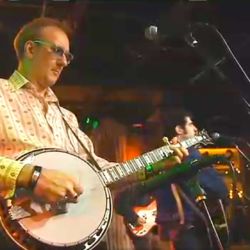1956 Gibson RB-250 Mastertone “Bow-Tie”
- Rim: Maple (with the Tone Bell rim modification)
- Resonator: Mahogany
- Neck: Mahogany
- Hardware: Price Straightline tailpiece, Waverly V2 tuners (plus two Keith tuners on the G & B), Huber flathead bronze tone ring, old wood 11/16” maple/ebony bridge with compensated G-string slot
So-named as a poke at this investment banker git who used to show up at NYC bluegrass jams with the latest pre-war Gibson Mastertone he had just bought to lord over us. Despite their age and legendary status, they all sounded like they were stuffed with dirty gym socks, whereas my “less than desirable” mid-50’s bowtie had the magic in it, was louder than god, and every bit as intrusive.
In terrible shape when I bought it in 1998, having sat in a puddle in someone’s New Jersey basement for 15 years, I had to have it field-stripped, extensive rust sandblasted off the hardware and then reassembled (restoration work done by Janet Davis Music). Originally came with a 4-hole archtop tone ring, which I replaced with a Huber flathead. The Tone Bell rim modification removes some of the wood around the tone ring, eliminating the air pocket between the ring and the rim, with a bump in volume, and even a bit of “reverb.”
Charlie Cushman, who works on my banjos, tells me it’s likely a 1956, or maybe ’58, though the rim might be a pre-war factory leftover. I whinge every time I have to take this on tour, so a spare will be needed before long so I can retire it from travel.
When I have to compete with drums and electric guitars I use a GoldTone ABS dynamic banjo mini-mic that clips onto the flange and works quite well. I use a custom “medium light” string gauge set suggested by Bill Keith: .11, .11, .15, .22 (bronze), .11 that D’Addario makes for me. The .11 on the B-string makes choking notes especially easy.
Sadly, Gibson stopped making banjos after the 2010 Nashville flood. Can you believe that?












